Forest fires: top, bottom, underground. Ground fire: types, characteristics, causes and extinguishing rules
Forest fires are a real disaster, they cause considerable harm to both nature and man. However, oddly enough, fire is capable of exerting positive influence on vegetation. Let's figure out when a forest fire becomes an enemy for us, and when a friend.
Unmanaged distribution
Fyodor Nikitin
A forest fire is commonly understood as a spontaneous, uncontrolled spread of fire across a forest area.
In general, fires cause great damage to forestry and the country's economy: wood burns, tree growth decreases, the composition of plantations and their sanitary condition deteriorate. Fires absorb oxygen, emit carbon dioxide and carbon monoxide into the atmosphere, and increase the greenhouse effect.
More than 95% of fires occur through the fault of a person, and not as a result of deliberate arson, but due to non-compliance with elementary rules fire safety. In the forests of the Moscow region, the situation is complicated by the frequent burning of agricultural land bordering forests. After the collapse of state farms, most of the agricultural land is not cultivated, overgrown with weeds, which, drying up, in spring and autumn form a flammable material. Fire in the fields spreads at high speed and often turns into forest plantations.
There are three types of forest fires: ground, crown and underground.
ground fires
Most often there are grassroots Forest fires, which, according to the speed of the spread of fire and the nature of combustion, are usually divided into fugitive and stable.
Runaway ground fires usually occur in the spring in grassy forests, when the top layer of litter and last year's grass dries up. In such a fire, the fire spreads at a speed of 3 – 5 m / min, damaging undergrowth, undergrowth, shrubs and other plants of the lower tiers. Tree stands during ground fires suffer slightly. Significant damage is caused to animals, birds and insects.
Persistent ground fires characteristic of green moss forest types, in which green mosses, blueberries, lingonberries and oxalis grow. Coniferous forests predominate in such forests; a litter layer up to 15 cm thick is formed on the soil from fallen needles, cones, small branches, bark, and leaves.
During a dry summer, the litter dries up to the full thickness of the occurrence and becomes flammable. Under such conditions, stable ground fires develop, the speed of their spread is much lower, 1 – 3 m / min, and they can last for several days.
For example, under the crowns of ancient firs, the smoldering litter burns out completely in 2 – 3 days, while the roots and bark of trees are damaged. As a result, tree species with shallow root systems and thin bark, such as spruce, die. In pine and larch forests, up to 30% of trees dry out, the rest weaken. Plantations damaged by fires often become hotbeds for the development of dangerous pests and diseases. Steady ground fires completely destroy herbaceous vegetation, undergrowth, undergrowth, partially soil humus, seeds located in the litter and upper soil layers. Animals, birds and insects suffer to a greater extent than in a runaway fire.
In forestry, for the destruction of logging residues, fire cleaning of cutting areas has long been used, in which the spread of fire is controlled by man. There is no consensus among domestic and foreign scientists regarding the fire cleaning of cutting areas.
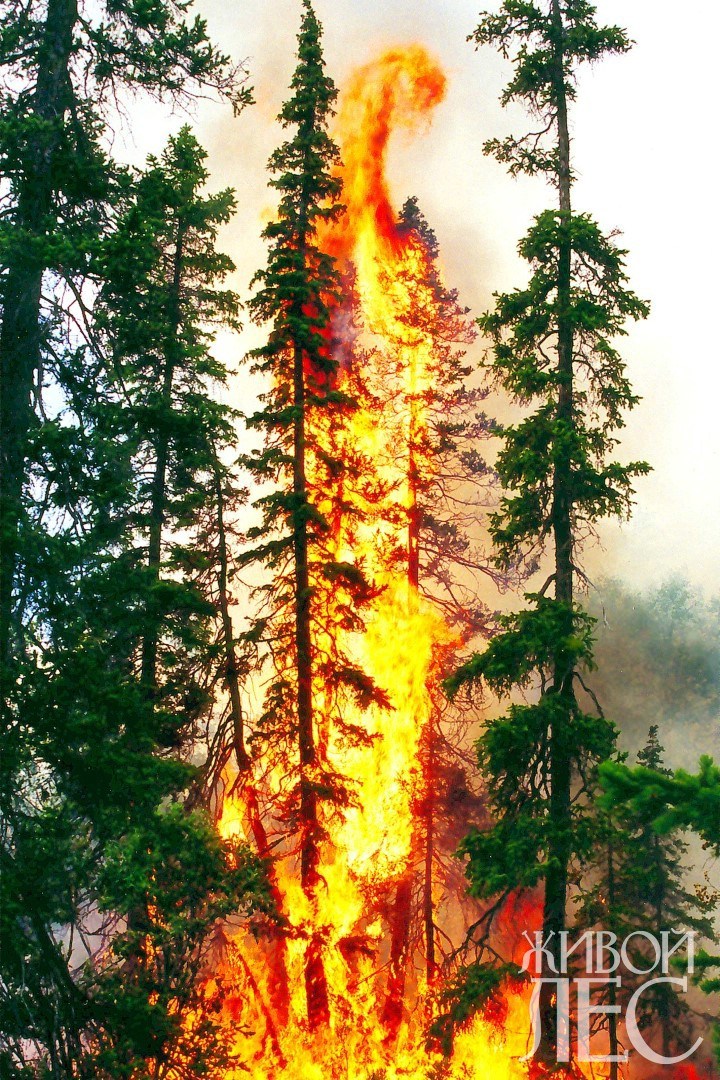 forest fire
forest fire 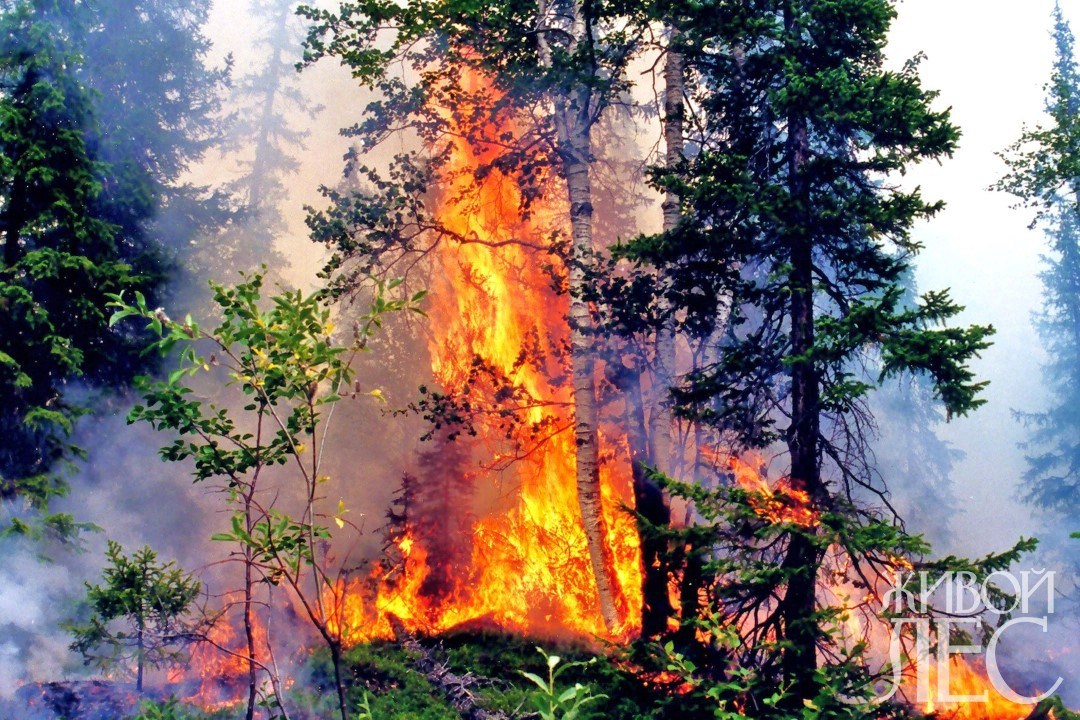
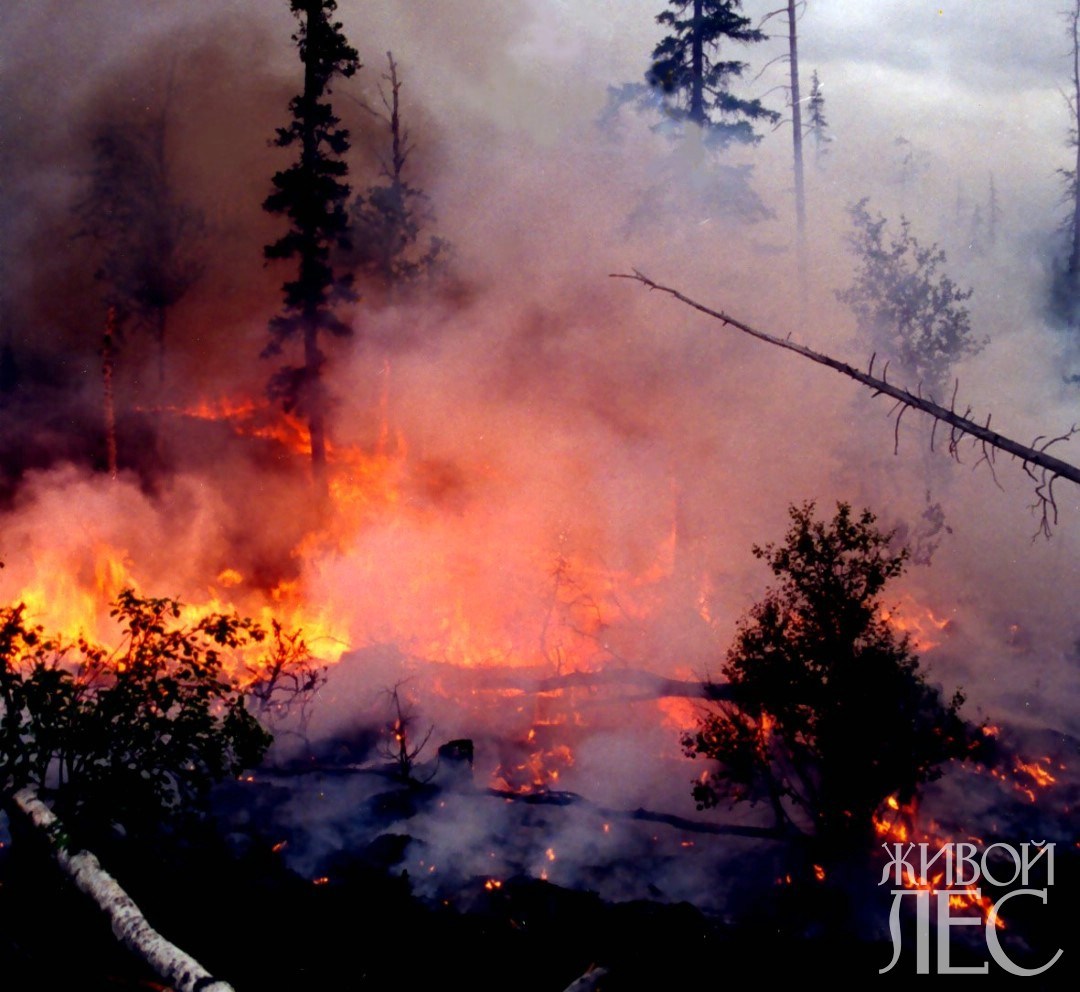
Positive value:
- improvement of the sanitary state of cutting;
- reducing the risk of fires after burning the bulk of organic matter;
- improvement of conditions for the natural renewal of tree species.
Negative impact:
- large losses of bound nitrogen, as a result of which the nitrogen balance of the soil is disturbed, and this leads to a deterioration in its physical properties;
- destruction of undergrowth, seeds of trees and shrubs, useful representatives of insects and microorganisms.
 Riding fires
Riding fires
During crown fires, fire covers not only the ground cover and litter, but also the crowns of trees. The spreading speed can reach 350 m/min. Such fires occur in dry weather with strong winds, more often in coniferous plantations. Coniferous young growths, due to low-lowered crowns, can also burn in light winds. Crown fires have great destructive power, they lead to the complete death of forest stands and all components of forest biocenoses. Fire destroys buildings, power lines, people often die in fire.
Forest peat or underground
Forest-peat or underground fires occur primarily on drained forest lands. After the peat fires forest areas turn into blockages from a burnt forest, deep soil failures. The reconstruction of such lands is very laborious, and they are usually excluded from forestry for several decades. Peat fires are difficult to extinguish and continue to burn even after heavy rains. Forest fires lead to prolonged smoke in large areas, serious disruption of air and ground transport, numerous accidents with tragic consequences, and harm people's health.
At present, with the adoption of the new Forest Code of the Russian Federation, most of the forest land is given for long-term lease. To reduce fire hazard it is necessary to develop a system of measures and standards for the targeted formation of fire-resistant plantations on leased forest lands and oblige forest owners to comply with these requirements. With this approach, it is possible to achieve effective control over the forest fire situation.
When Fire Benefits
Sergei Shkarinov, candidate of agricultural sciences
Over the past year and a half alone, the whole world has more than once followed the heroic fight against forest fires in Australia, Portugal, Spain, Greece and California. And in all cases, the person in this struggle turned out to be the loser. However, fire is not only a destructive element, but also a natural phenomenon, with the direct participation of which the Earth's biosphere was formed and the evolution of living organisms took place.
pyrogenic species
A life higher plants, from the very first primitive ancestral forms to the whole variety modern species, proceeds against the background of two processes - photosynthesis (the creation of organic matter) and combustion (its destruction during combustion). In different parts of the globe, plant communities have been destroyed by fire from time to time. Such an impact predetermined the emergence of adaptive adaptations in plants aimed at restoring plant communities to replace those destroyed by fire. This is how pyrogenic species arose, the reproduction of which is possible only in burnt areas - territories freed by fire from the vegetation that previously existed on them.
A classic example of pyrogenic plants are eucalyptus trees - evergreen trees and shrubs of more than 500 species that grow in Australia and its surrounding islands. characteristic feature species that form eucalyptus forests in a dry climate is a specific feature of their seeds, which cannot germinate without exposure to high temperatures. Thus, seed renewal of these species is possible only after forest fires.
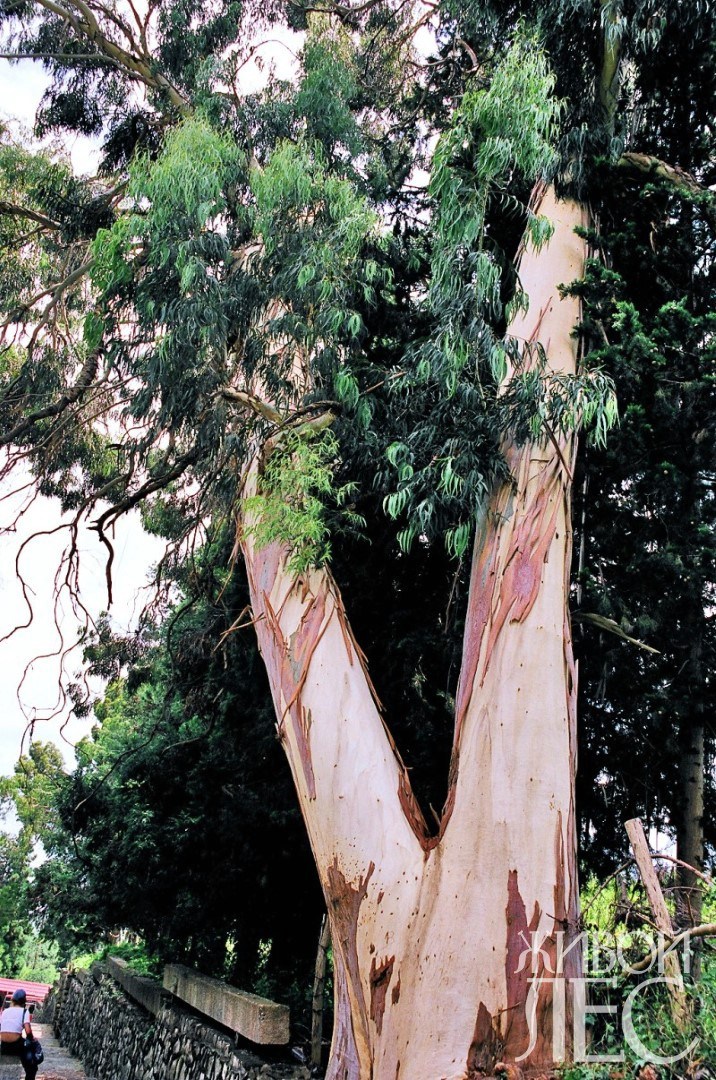
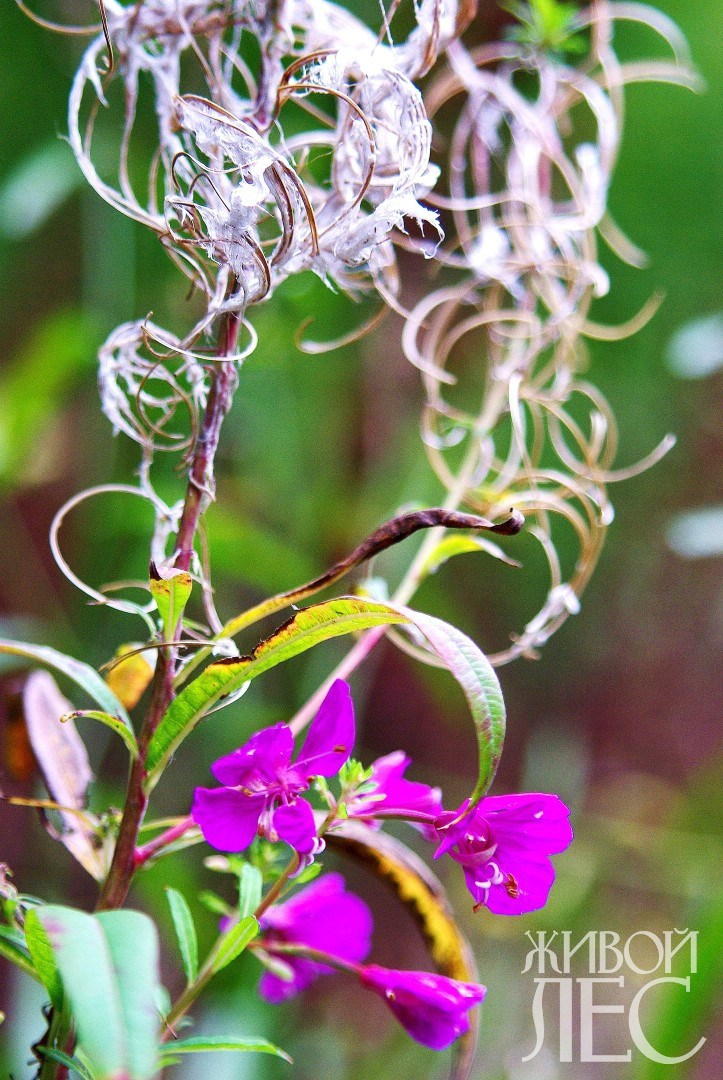
Almost all light coniferous - larch and pine virgin forests of the taiga zone are of pyrogenic origin, i.e., formed on forest fires. The most important biological feature of Scotch pine and all types of larch is photophilous. These species did not develop evolutionary adaptations that allow them to regenerate under the forest canopy, and there was no need - forest fires regularly prepared territories for their successful seeding. However, it is far from always that light-coniferous tree species are successfully restored in the burnt areas, and after 10–15 years, the depressing black scorched desert with sticking out charred remains of trunks is replaced by dense coniferous young forests pleasing to the eye. Often, for a certain period of time, burnt areas can be populated by herbs, among which there are also pyrogenic species.
Ivan-chai is a large perennial (up to 2 m tall) from the fireweed family, whose biology is closely related to the effects of fire. The plant produces a huge amount of tiny seeds with fluff-like appendages that can spread over long distances and densely seed large areas. However, they cannot germinate under normal conditions - this is prevented by the living cover of plants covering the soil. Burnt areas are an ideal place for mass germination of Ivan-tea seeds.
With the help of fire
Man has long learned to use the power of the impact of fire on vegetation. Even our ancestors in the Middle Ages successfully used the system of fallow farming. To do this, the most conveniently located areas of the forest were burned out and grain and fodder cereals, as well as flax, were sown in the liberated territory. Palom created conditions that ensured high yields of these crops for several years. When the soil was depleted and the yields began to decline, they moved to a new place prepared in advance with the help of the fell. The abandoned areas were gradually overgrown with forest again. Almost all forests located not far from settlements, grew up on lands in the past cultivated with palom.
The positive effect of fire was also successfully used in silvicultural practice. The well-known German arborist Karl Francievich Türmer considered natural regeneration to be appropriate only in a very limited number of cases and was a strong supporter of forest planting. However, few pay attention to one technological feature which he used. Seedlings were always planted in ash ridges. Thus, the best man-made forests in Russia were created with the help of fire at the stage preceding planting. On forest clearings, after burning logging residues, ash ridges were formed, which served perfect place for planted seedlings.
When using this technology, several goals are achieved at once, ensuring unhindered growth and harmonious development of plants. Firstly, the site is disinfected, which destroys the pests and pathogens that existed in the cut forest, which persist in the soil and felling residues; secondly, it temporarily eliminates competition from herbaceous plants and natural regeneration of small-leaved tree species and shrubs. Grown by K.F. Tyurmer forests in terms of their productivity and other important taxation indicators are several times superior to their natural counterparts.
Talking about some positive aspects the impact of fire on vegetation, we must not forget about the negative role of the fire element. The main culprit of plant fires in modern world is a man. In Russia, fires most often occur in spring, during the spring drought, and in summer, at the hottest time.
Who is to blame and what to do?
Speaking about some of the positive aspects of the impact of fire on vegetation, one should not forget about the negative role of the fire element. Before man learned how to make fire, the most real factor causing vegetable fires was thunderstorms, and ignition from lightning happened relatively rarely, because usually a thunderstorm is accompanied by a downpour that prevents the spread of fire.
The main culprit of plant fires in the modern world is man. In Russia, fires most often occur in spring, during the spring drought, and in summer, at the hottest time. In the spring, the main cause of forest fires can be last year's dead grass, which is preserved in abundance in clearings and forest edges. A carelessly thrown match or cigarette butt is enough to dry up in the sun and a fresh breeze, withered grass flares up and starts a ground fire. In some cases, the source of the fire may not even be an open fire, but, for example, a broken bottle, the glass of which, like a lens, focuses sunlight.



For owners of private estates with woody vegetation or bordering forest areas, the following basic rules can be recommended to prevent the occurrence of fires or the spread of fire from adjacent territories:
- In late autumn or early spring, carefully mow dry grass along the edge of the stand and under the trees.
- Eliminate the prerequisites for exposure to open fire on woody plants. In particular, shish kebabs, barbecue, chimneys baths, other buildings should be located on safe distance from tree crowns.
- to plant coniferous trees separate biogroups with fire breaks between individual curtains, for example, sown with lawn.
- In case of direct adjoining of forest areas to private territory:
a) in coniferous young stands - to arrange fire breaks with the installation of mineralized strips on them;
b) in middle-aged, ripe and overmature stands different composition- regularly clean up deadwood and dead litter; mow the edges.
- In areas with peat soils- delimit private territory ditches deeper than a layer of peat, followed by filling them with non-combustible materials (sand, loam, gravel, etc.).
- Take seriously the requirements of the fire inspection, not considering them empty nit-picking.
If you are in a fire zone
- Do not try to extinguish a crown fire on your own (when the crowns of trees are burning), it is very dangerous, and you still cannot cope with it.
- Don't get close to a peat fire: it spreads underground and you can fall into the burning peat.
- When you are near a fire, first of all, protect your respiratory organs - in a fire, people often die not from fire, but from suffocation with smoke. Drink plenty of water, wet your clothes.
- If you live in a risk area natural fires, keep a bag or backpack ready with documents, money and essentials. In alarming situations, arrange with the neighbors on duty so that the fire does not take you by surprise. In the event of a fire, call fire department Ministry of Emergency Situations: 01 or 112, on hotline 8-800-100-94-00 , or to the district administration (the phone number can be found at the post office or railway station). Be sure to warn your neighbors!
Posted on 04/10/2008
Forest fire is a spontaneous uncontrolled spread of fire in the forest fund. Fires are usually divided into 3 types: riding, grassroots and soil (underground, peat).
A ground fire is characterized by the spread of fire over the ground cover. Burning forest litter, consisting of small branches, bark, needles, leaves; forest floor, dry grass and herbaceous vegetation; living ground cover of grasses, mosses, small undergrowth and bark in the lower part of tree trunks.
According to the speed of fire spread and the nature of burning, ground fires are characterized as fugitive and stable.
A runaway ground fire develops most often in the spring, when only the topmost layer of small combustible materials of the ground cover and last year's grassy vegetation dries up. The speed of fire propagation is quite significant - 180 ... 300 m / h (3 ... 5 m / min) and is directly dependent on the wind speed in the surface layer. Forest litter burns down by 2…3 cm. high humidity the ground cover remains untouched by fire and the area covered by rapid fire has a spotted shape.
A stable ground fire is characterized by complete combustion of the ground cover and forest litter. Stable ground fires develop in the middle of summer, when the litter dries out over the entire thickness of the occurrence. Forest litter, undergrowth and undergrowth are completely burned in the areas covered by a sustained fire. The roots and bark of trees are burned, as a result of which the plantation receives serious damage, and some of the trees stop growing and die. The rate of spread of fire in a stable ground fire is from several meters to 180 m/h (1…3 m/min). The minimum flame burning speed is 0.2 m/min.
According to the height of the edge burning flame, ground fires are characterized as weak (flame height up to 0.5 m), medium (flame height up to 1.5 m) and strong (flame height over 1.5 m).
Horse fire.
The crown fire is characterized by the burning of the crowns of forest stands and is subdivided into fugitive and persistent fires. With a fluent crown fire, the fire quickly spreads through the crowns of trees in the direction of the wind, and with a stable (general) fire, the fire spreads throughout the forest stand: from the litter to the crowns. Separate trees and curtains are burning. The emergence and development of crown fires occurs from the transition of the fire of ground fires to the crowns of coniferous stands with low branches, in multi-tiered plantations with abundant undergrowth, young stands, and also in mountain forests. The speed of crown fires: stable - 300 ... 1500 m / h (5 ... 25 m / min), runaway - 4500 m / h and more (75 m / min). The minimum speed of spreading the crown fire is about 4500…4800 m/h (75…80 m/min).
Coniferous young growths, thickets of elfin cedar and bushy oak (in spring with dry last year's leaves) are most susceptible to crown fires, in mountain forests - all coniferous plantations in the upper part of steep slopes (more than 25 °) and on passes. Droughts and strong winds largely contribute to the emergence of crown fires.
Soil fire.
Soil fire develops as a result of the “deepening” of the fire of a ground fire in the litter and peat soil layer.
Soil fires are subdivided into: litter-humus, in which combustion spreads over the entire thickness of the forest litter and humus layer, and underground, or peat, in which combustion spreads along the peaty horizon of the soil or peat deposit under the layer of forest soil. In such a fire, the roots burn out, the trees fall out and fall, usually with their tops towards the center of the fire. The fire in most cases has a round or oval shape. The rate of spread of fire is negligible - from a few tens of centimeters to several meters per day.
fire elements
The names of the elements of a forest fire, developed by the practice of forest fire work, are shown in fig. 1. A unified approach to names individual elements fire will provide mutual understanding in the organization of its extinguishing.
Rice. 1. Elements of a forest fire
fire shape
Depending on the development, a forest fire has a certain shape: 1) a rounded shape is observed with a uniform spread of fire in calm weather with homogeneous combustible materials and relatively flat terrain; 2) an uneven (versatile) shape is observed with a variable wind, dissimilar combustible materials, rough terrain; 3) an elliptical (elongated) shape is observed with wind, relatively flat terrain, and uniformity of combustible materials.
The shape of the fire and its area determine the length of the forest fire edge.
| Discuss on the forum |
|
| |
|
Types:
ground fire
In case of a ground fire, forest litter, lichens, mosses, grasses, branches that have fallen to the ground, etc. burn down. The speed of the fire in the wind is 0.25-5 km / h. The height of the flame is up to 2.5 m. The combustion temperature is about 700 ° C (sometimes higher).
Ground fires are runaway and stable:
With a runaway ground fire, the upper part of the ground cover, undergrowth and undergrowth burn out. Such a fire spreads at high speed, bypassing places with high humidity, so part of the area remains unaffected by fire. Runaway fires mainly occur in the spring, when only the topmost layer of fine combustible materials dries out.
Stable ground fires spread slowly, while the living and dead ground cover completely burns out, the roots and bark of trees are severely burned, and the undergrowth and undergrowth are completely burned. Stable fires occur mainly from mid-summer.
horse fire
The crown forest fire covers leaves, needles, branches, and the entire crown; it can cover (in the event of a general fire) the grass-moss cover of the soil and undergrowth. The propagation speed is from 5-70 km/h. Temperature from 900 °C to 1200 °C. They usually develop in dry windy weather from a ground fire in plantations with low crowns, in plantations of different ages, as well as in abundant coniferous undergrowth. A crown fire is usually the final stage of a fire. The area of distribution is ovoid-elongated.
Mounted fires, like ground fires, can be runaway (hurricane) and stable (general):
A hurricane fire spreads at a speed of 7 to 70 km/h. Occurs in strong winds. Dangerous high speed of distribution.
In the case of a wholesale crown fire, the fire moves in a solid wall from the ground cover to the crowns of trees at a speed of up to 8 km / h. In a general fire, the forest burns out completely.
During crown fires, a large mass of sparks is formed from burning branches and needles, flying in front of the fire front and creating ground fires several tens, and in the case of a hurricane fire, sometimes several hundred meters from the main focus.
underground fire
Underground (soil) fires in the forest are most often associated with the ignition of peat, which becomes possible as a result of the drainage of swamps. They spread at a speed of up to 1 km per day. They can be hardly noticeable and spread to a depth of several meters, as a result of which they represent an additional danger and are extremely difficult to extinguish (Peat can burn without air and even under water)]. To extinguish such fires, preliminary reconnaissance is necessary.
Peat fires- a type of forest fire in which a layer of peat and tree roots burn. Forest fires are divided into crown, ground and soil (peat) fires. The fire spreads at a speed of up to several meters per day. Often peat fires represent a stage of development of ground fires, or pass into a ground fire when they are blown up by the wind. When the soil burns out under the trees, the latter randomly fall.
When observed from the air, the borders of a recent fire are poorly distinguishable, smoke rises from the entire fire area, and no fire is visible.
The depth of burning of peat is limited only by the level of groundwater or the underlying mineral soil. The burning of peat deposits is resistant to precipitation due to the hydrophobicity of bituminous peat particles. This leaves moisture in ground water past the peat particles, and the peat continues to burn up to the complete burnout of the deposit. In the winter of 2002, the peatlands burned under the snow until the spring flood began.
Extinguishing methods
1. Overwhelming fire - knocking down the flame at the edge of burning towards the burnt area with choppers, branches or other improvised means, if possible wet. In this case, the blows of a rag or other extinguishing tool must be strong, applied under the base of the flame and be sliding towards the fire. The effect is achieved by "breaking" the flame, throwing burning particles onto the burnt area. It is used for extinguishing weak and medium grass and ground fires.
2. Knocking down the flame at the edge of the fire with the help of special blowers. Blowers are a compressor with a gasoline engine, it can have a water tank of 17-20 liters and a barrel into which a jet of air and water is supplied. The effect is achieved due to the "breakdown" of the flame with a jet of dry air or finely sprayed water, blowing off combustible materials towards the area passed by the fire. Water supply is recommended to be carried out during particularly intense combustion. In other cases (with a low flame), extinguishing with dry air is also quite effective. It is used for extinguishing grass and ground fires of any intensity. It works effectively even when extinguishing burning reeds, when the height of the flame can reach 3-5m in height.
3. Extinguishing a fire with water or solutions of fire extinguishing agents provides a decrease in the combustion temperature and moistens combustible materials. For greater effectiveness, special wetting agents or liquid soap can be added to the water. At the same time, it is very important to choose substances that are as safe as possible for the environment. In this case, any improvised means (buckets, any containers) can be used, as well as special equipment: knapsack forest fire extinguishers, motor pumps, tank trucks, etc. The backpack forestry sprayer consists of a soft 20 liter water tank worn on the back like a backpack and a two-way hand pump (hydraulic control). A special nozzle allows you to deliver a compact and atomized jet at a distance of 2-7 meters. The water supply is enough for 10-15 minutes of intensive work. To fill a knapsack fire extinguisher with water, buckets, ladles or other containers are used that you need to have with you when working on a fire. It is used to extinguish grass and ground fires of any intensity. water tanks in the form of a cone, with handles, a tap for draining water and a hermetically sealed neck. The volume can be different from 100 to 1500 liters. The convenience lies in the fact that it can be carried by several people, or brought on mopeds, ATVs, etc. to the fire extinguishing site.
4. The motor pump is designed to supply water from open reservoirs, pumping water when extinguishing fires. Full autonomy in operation, simplicity and reliability of designs, simple handling rules make motor pumps indispensable for extinguishing fires in natural areas. The high mobility of portable motor pumps allows them to be installed on water sources almost anywhere inaccessible to heavy fire trucks. Motor pumps consist of an engine and a water pump mounted on a common frame. Depending on the power, they deliver 600-1200 l / min, weigh 15-40 kg, and carry 1-2 people. They are joined by an intake hose with a mesh filter for lifting water from a water source and a hose line for supplying water to a fire extinguishing site. When working with motor pumps, fire hoses with a diameter of 77, 66, 51, 25 mm are most often used. Branching can be connected to the hoses, which allows dividing the total water flow into several and extinguishing from 2-3 trunks. The hose line from the pump to the branch is called the trunk line. Fire hoses with the largest diameter available are usually used. Fire hoses extending from branching to trunks form working lines. In calculations, it is usually assumed that the pressure loss is in ideal conditions 1 atm. at 100 m. In reality, with even a slight rise, bends in the hose line and the use of branches, the pressure loss can be 2-3 times greater. Therefore, the actual length of the line is about 300 m. It is possible to work with motor pumps through intermediate tanks. To do this, one motor pump is placed on the water source and pumps water into the tank, the second one takes it from the tank and delivers it to the place of fire extinguishing. Motor pumps are used to extinguish peat fires. It can be applied at top and intensive ground fires in the presence of sufficient amount of water.
5. To extinguish underground fires, special peat shafts are used in the form of hollow tubes with holes through which water is supplied to the thickness of the burning peat. Trunks are stuck at a distance of 30-40 cm from each other.
6. Extinguishing (stopping the spread of combustion) by laying barrier strips (ditches) manually with rakes, shovels, mechanisms, chemical solutions, foams to isolate the burning edge of the fire from combustible materials. Throwing fire with soil is used on light sandy and sandy loamy soils. The soil is collected on a shovel and thrown under the base of the flame of the burning edge so as to bring down the flame over its greatest extent. On soddy soils, soil is collected from pits formed when the sod is removed. Separate foci of combustion (fallen trees, stumps) are completely covered with soil.
7. Annealing - the destruction of combustible materials in front of the impending forest fire front by burning forest combustible materials from the reference strip (road, stream, mineralized strip, furrow, etc.) towards the fire. This operation can only be performed by specially trained forest firefighters.
Exit from the fire zone
avoid panic;
immediately warn everyone nearby about the need to leave the danger zone;
organize the exit of people to the road or clearing, a wide clearing, to the bank of a river or reservoir, in a field;
leave the danger zone quickly, perpendicular to the direction of fire;
if it is impossible to escape from a fire, enter a body of water or cover yourself with wet clothes;
being on open space or a clearing, breathe, bending down to the ground - there the air is less smoky;
cover your mouth and nose with a cotton-gauze bandage or cloth;
after leaving the fire zone, report its location, size and nature to the fire service, the administration of the settlement, forestries
Forest fires occur quite often. In order for a dry tree to catch fire, just one small spark or lightning strike is enough. Considering that in most countries weeds are set on fire in the fields, the number of fires increases several times.
The larger the territory of the country, the more fires occur on it. And if a persistent drought prevails, then trees and shrubs can ignite for no apparent reason at all. There is a ground fire and a crown fire, there are also soil fires and a host of other types of fires. But first things first.
What is a forest fire
This term refers to uncontrolled fire, which spontaneously spreads through the forest. In the process of such a fire, partial or complete burnout of vegetation located above ground level, forest litter (fallen leaves, branches, etc.) and fertile soil layer occurs. As a result, nothing grows in the area affected by the fire for a long time. In addition, animals often die due to forest fires.
Natural disasters of this type are very dangerous, as the fire spreads very quickly over vast areas. Most often, by the time a forest fire is detected, it covers large areas, which greatly complicates the extinguishing process.
Causes
Most often, fire appears from lightning, they account for more than 8% of fires. It all depends on the area itself. In forests where young trees predominate, natural disasters seen much less frequently.

Another cause of forest fires is people. In some situations, fire comes from a deliberate act to kill weeds. In addition, in the spring and summer, people go to barbecue or pick mushrooms. In this case, one unextinguished cigarette or firebrand in a fire is enough. As a result of such negligence, dry grass instantly ignites, and flames very quickly spread to dry wood.
Classification of forest disasters
Based on the nature of the fire, soil, ground and crown fires are distinguished. Further, natural disasters are classified according to the speed of propagation. Based on this, ground fire is divided into the following categories:
- Weak. A fire up to 0.5 m high covers 1 meter of territory in just a minute.
- Medium (height up to 1.5 m). Spreads at speeds up to 3 m/min.
- Strong (more than 1.5 m). Covers 3 meters in less than 3 minutes.
In turn, the speed of the crown fire is:
- Up to 3 m/min. This speed is considered weak.
- From 3 to 100 m/min. In this case, we speak of the average propagation velocity.
- Over 100 m/min. - strong fire.
From this it can be seen that a stable crown fire spreads at a speed of more than 100 meters in one minute. Accordingly, its scale is simply impossible to imagine.
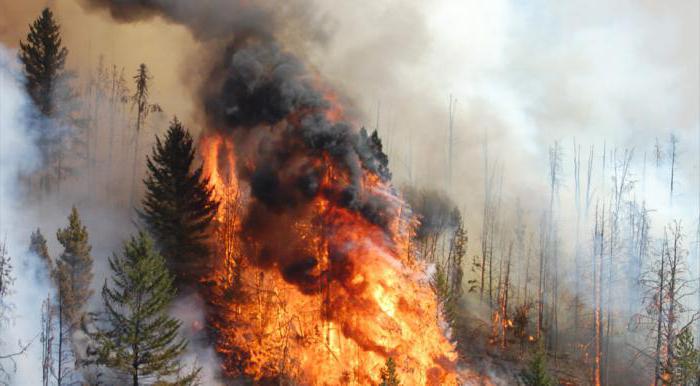
There is also a ground fire, which also spreads quite quickly. This takes into account the depth of burnout:
- Less than 25 cm is a weak fire.
- From 25 to 50 cm - medium.
- More than 50 cm - belongs to the category of strong.
In addition, the fire is classified according to the area of ignition:
- From 0.1 to 2 ha is typical for a normal fire.
- Up to 20 hectares indicates a small fire.
- 20-200 ha is an average fire.
- Up to 2000 ha is typical for a major disaster.
- Over 2000 hectares is already a disaster.
If we talk about the duration of the disaster, then during crown fires, the territory burns for about 10-15 days (depending on the level of fire). During this time, more than 500 hectares can burn out. Let's take a closer look at each type of fire.
Riding forest fire
Each fire is extremely dangerous for wildlife, animals, birds and, of course, for humans. Very often, the flame reaches small grayings located near the forest. As a result, the fire quickly covers the house. Therefore, if an unusual haze appears in the sky, there is a smell of burning, then you must immediately contact the Ministry of Emergency Situations.
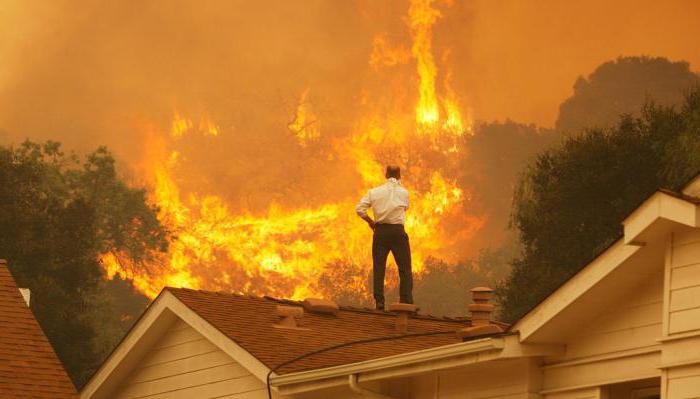
Crown fire affects the forest canopy. Most often, this type of fire results from the development of a low flame. Thus, we can say that the ground fire is a component of the top one.
The emergence of fire, which is above the surface of the soil, is facilitated by natural factors. For example, strong winds and steep slopes can cause crown fires to spread rapidly. Most often, such fires occur in the summer, when dry and hot weather prevails.
In this type of fire, the trees usually die completely. If we talk about the nature of combustion, then a fluent and stable crown fire is distinguished. The latter type is characterized by the fact that the crown of the tree burns out gradually, as the ground fire develops. In this case, the flame does not move along the canopy. Such fires are also often referred to as general fires. If we talk about a runaway fire, then in this case the fire, on the contrary, spreads along the canopy and can even outpace the movement of a ground fire. Also in this case, flame jumps are observed, at the moment of which the fire can hit areas at a higher speed.
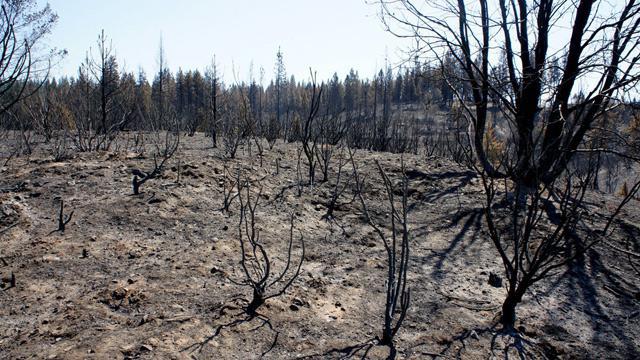
As mentioned earlier, crown and ground fires are practically one whole. Therefore, it is worth saying a few words about the second type.
Ignition in the lower tiers
In a ground fire, the fire moves along the underlying layer. First of all, grass, undergrowth, and also undergrowth light up. A ground fire usually moves in a semicircle, forming a contour of the main flame on the ground. The result is an edge.
![]()
If we talk about the nature of fires, then ground burning can also be fluent or stable. In the first case, the edge of the fire moves very quickly at a speed of more than 0.5 m/min. As a result, only the soil cover burns out. If we are talking about a stable ground fire, then in this case the speed of the circuit is much lower. Accordingly, not only the underlying layer burns out, but also rotten stumps and deadwood. In this case, a strong formation of smoke is observed.
soil ignition
Underground fires affect the root system of trees. They do not have a pronounced flame. A soil fire spreads deep into the earth and can move at a speed of up to 1 km per hour. At the same time, such fires are considered the most difficult, since they are very difficult to extinguish. A soil fire causes a grassroots fire, which in turn provokes the appearance of a top flame.
Extinguishing activities
For fire fighting, a wide variety of equipment is used: helicopters and airplanes. Thanks to the drain of liquid extinguishing compounds, the fire can be localized quite quickly. To determine the source of fire, screening of the area is carried out.
However, in some cases, annealing (backfire) is formed. It burns fire extinguishing fluids even before they arrive. In this case, a shock wave is applied. To do this, an explosion is made in front of the fire front, which initiates the appearance of a reflective screen. Thanks to this, it is possible to stop the further spread of the flame and carry out extinguishing by standard methods.
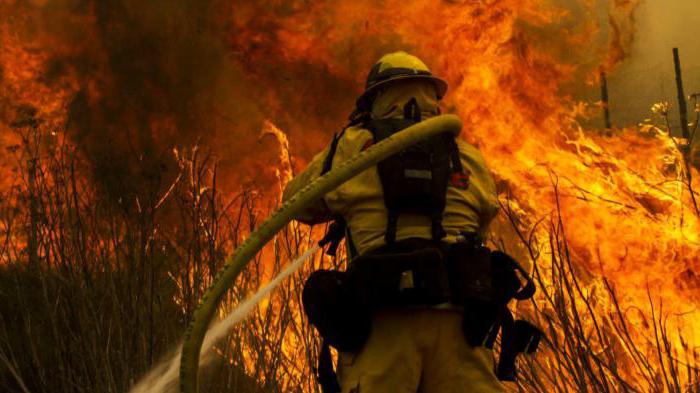
Preventive measures
First of all, experts are trying to predict the occurrence of fire in a particular area, based on weather conditions and data received from the area. In this case, the forest fire coefficient is calculated.
In order to reduce forest loss, mass organizational measures. First of all, fire-fighting and preventive work is carried out. Sanitary deforestation is also carried out. In this case, all old and dried trees are destroyed. Forest belts that are dangerously close to settlements are also being cut down. Special trenches are laid along the line of the forest, which, in the event of a fire, will not allow the fire to pass further.
In addition, forest fires are periodically monitored, special observation masts and towers are installed. Thanks to ground observation, it is very often possible to prevent the occurrence of a natural tragedy.
1. Classification of fires by distribution zones
From the point of view of the production of work related to localization, fire extinguishing, saving people and property, the classification of fires is carried out in three main areas:
- individual fires
- massive and continuous fires
- fires and smoldering in the rubble.
Natural fires are:
- forest
- peat
- steppe (field)
All forest fires pose an extreme danger, since by the beginning of localization they usually have time to cover large areas, and the means of struggle are not enough. Particularly terrible are the mass fires that occur in dry weather, and their total area is hundreds of thousands of hectares. In this case, there is a threat of destruction by fire of settlements and objects of the national economy located in forest areas, as well as strong smoke and gas pollution even in large settlements remote from forest areas.
Individual fire zone is an area where fires start separate sections. Such fires are dispersed throughout the region, so it is possible to quickly organize their mass extinguishing.
Zone of massive and continuous fires- a territory where there are so many fires and fires that it is impossible to pass or find the relevant units in it without carrying out localization or extinguishing measures; and rescue operations are practically excluded.
Such zones arise under certain conditions: continuous development of the forest, a large number combustible materials, etc.
A special form of continuous fire is a firestorm.
It is characterized by flows resulting from the combustion of a large amount of materials and formed a convection flow (column), to which air masses rush at a speed of more than 15 m/s.
A firestorm can form when following conditions:
- the presence of building or spreading flammable liquid on an area of at least 100 hectares.
- relative air humidity less than 30%
- availability a certain amount combustible materials in the respective area - in terms of wood, about 200 kg/m2 on an area of 1 km2.
The zone of fires and smoldering in the rubble is characterized by strong smoke and prolonged (over 2 days) burning in the rubble. The use of the relevant units is limited due to the danger to human life due to thermal radiation and the release of toxic combustion products.
Such smoke is considered hazardous open area, at which visibility does not exceed 10 m. The concentration of carbon monoxide in the air of about 0.2% causes fatal poisoning within 30-60 minutes, and 0.5-0.7% - within a few minutes.
Features of large forest fires:
- occurs during dry periods, most often with strong winds
- take place against the backdrop of a massive outbreak of small and medium-sized fires
- continue for several days
- spread at high speed
- the nature of combustion at the edge is very diverse
- easily overcome various barriers and obstacles (mineralized strips, roads, rivers...)
- cause heavy smoke in vast areas, hindering the actions of aviation and ground forces.
2. Types of forest fires and their distribution
Depending on the nature of the fire and on which elements of the forest (forest composition) the fire spreads, forest fires are divided into:
- grassroots
- - riding
- underground (soil)
A grassroots fire is a forest fire that spreads over the soil cover.
There are two types of ground fire: fugitive and persistent.
A runaway is called a fire, in which the ground cover, fallen leaves and needles burn.
Sustainable fire is a fire in which, after burning the cover, the litter, stumps, deadwood, etc. are burning. It usually develops in summer, burning continues for a long time. Conditions for the development of crown fires can develop here. A ground fire is characterized elongated shape conflagration with uneven edges. The color of the smoke from a ground fire is light gray.
At night, the rate of fire spread is less than during the day.
The rate of propagation of ground fires in all directions is not the same and depends on the speed and direction of the wind, uneven distribution of combustible materials, their humidity, and other factors. Wind speed almost completely determines the contour of the fire. The stronger the wind, the more extended the contour of the fire in its direction.
According to the speed of propagation and height of the flame, ground and crown fires are divided: strong, medium and weak (Table 2)
table 2
Fire parameters |
Values of fire strength indicators |
||
middle |
strong |
||
ground fire |
|||
Flame height m |
|||
horse fire |
|||
Fire Spread Speed m/min |
|||
underground fire |
|||
Depth of burn, cm |
|||
Riding forest fires characterized by burning of the ground cover and forest stand. These fires arise from the lower ones as a further stage of their development, and the lower fire is integral part top fire.
Dense coniferous young stands are most susceptible to crown fires. Their occurrence is facilitated by a strong wind and a large steepness of the slopes, if a ground fire spreads uphill. Mounted fires occur more often in summer, when drought is combined with winds.
Distinguish fugitive and steady crown fires.
At sustainable fires tree crowns burn as the edge of the ground fire advances. There is no independent advancement of combustion along the canopy. Such fires can be called rampant.
At fugitive cavalry In fires, the spread of combustion along the canopy can outstrip the advancement of the edge of a ground fire. In windy weather, mostly fugitive crown fires occur, when the fire spreads along the forest canopy and outstrips the ground fire.
Riding fires are accompanied by the release of a large amount of heat. Therefore, crown fires affect the atmosphere much more strongly than ground fires. Heated air and combustion products cause updrafts and the formation of convective columns with a diameter of several hundred meters. Their forward movement coincides with the direction of the fire front advance. The flame in the middle of the column can rise to a height of up to 120 m. The convective column increases the flow of air into the fire zone and generates wind, which intensifies the fire. This particular form of solid fire is called fire storm.
Forest soil (underground) is the flameless burning of the upper peaty soil layer. The tree stand completely dies due to the exposure and burning of tree roots. Soil fires are observed in areas with peaty soils. The accumulation of peat in a certain area in the form of layers that are homogeneous or different in nature and thickness is called a peat deposit.
Peat- a young geological formation, arising as a result of the death of swamp vegetation with an excess amount of moisture and insufficient air access. Under the influence of temperature, humidity and other reasons, peat gradually decomposes. The higher the degree of decomposition of peat, the more it is susceptible to fire.
Peat fire is possible throughout the year, but most often in the second half of summer, when it dries up. Peat spontaneously ignites as a result of self-heating, as well as ignition due to sparks from fire sources and working machines, lightning discharges, etc.
Depending on the depth of burnout, underground fires are divided into strong, weak and medium (table 2).






